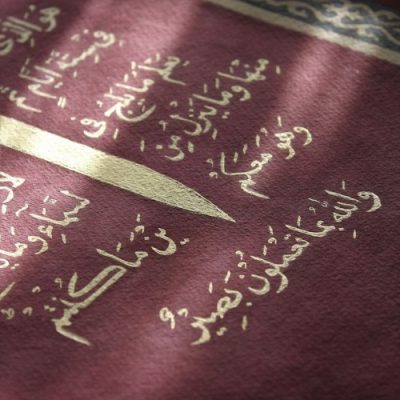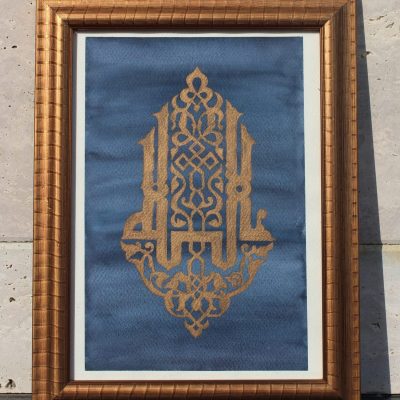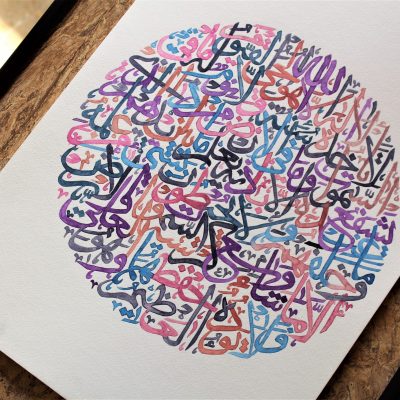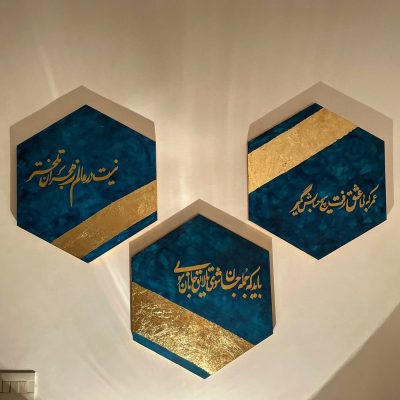Islamic Calligraphy – Type of Scripts
1. Kufic
Kufic is the oldest form of the Arabic script. The style emphasizes rigid and angular strokes. Due to its straight and orderly style of lettering, it was frequently used in ornamental stone carving as well as on coins. It was the main script used to copy Qur’ans from the 8th to 10th century.
‘The One’ artwork features the gold ornamental kufic calligraphy elements, emphasizing ‘Allah’ on a blue washed watercolor background.
2. Thuluth
Thuluth means one-third. It derives the name by the fact that in this style, every letter slopes in one-third. One of the characteristics of this script is the implementation of the Harakat, which is unseen in the prior Kufic style. The Harakat, also known as Tashkeel are the symbols signifying different meanings, often representing vowel sounds or sometimes as decorative accents.
‘Guardian’ showcases the amalgamation of Thuluth script with Harkat/Tashkeel elements in a round circular form, signifying the intricacy of this beautiful script.
3. Naskh
Naskh script is different from other fonts by its use of accent points, in the form of 1-3 dots above or below the letter, making the text more understandable and easier to read. Among the most prominent features is its response to linguistic needs, such as the clarity of letters and the ease of lecturing, which is why this script is commonly used in Islamic texts and publications.
‘Alif’ depicts how the letters in this script change its size as they are much smaller, often written in a straight line with proper Tashkeel elements.

4. Nastaliq
The name indicates the combination of elements of two predating styles, ‘Naskh’ and ‘Ta’liq.’ Nastaliq was the first style to be invented with the Persian language especially keeping literary texts in mind. There is no fixed level or height for any character in this script. The ‘Ta’liq’ element, meaning ‘hanging’ in Arabic, points to this style’s highly cursive nature, where the characters’ strokes literally ‘hang’ from the imagined horizontal line.
“Ishq – Rumi Series 04’ shows the simplicity and profoundness of this script as many calligraphers adopted this style to write the poetry of famous Persian poets.
5. Diwani
Diwani is considered one of the most decorative writing cursive scripts also based on the Ta‘liq style. It is written on a less dramatically hanging baseline, though its letter connections are vertical and slanted. It is characterized by dramatically curved undotted letters which are joined together in an unconventional fashion, and by ending swashes that often extend below the baseline of letters. Diwani is written without vocalization marks.
‘Exalt’ presents the elements of this script used to write Alhumdulilah-he Rabb-il Alameen in a cursive and joined fashion.
6. Muhaqqaq
The Arabic word ‘Muhaqqaq’ means “consummate” or “clear”, and originally was used to denote any accomplished piece of calligraphy. It has a precise, angular script with upright letters with carefully balanced ascenders and horizontal letters. The descending strokes end at straight, sharp points rather than turning upwards in a hook. It has been replaced by Thuluth script following the 18th century.
The starting verse Bismillah-hir-Rahmaan-Nir-Raheem of ‘Asma ul Husna’ painting shows how carefully the letters are written straight towards the ending strokes.











